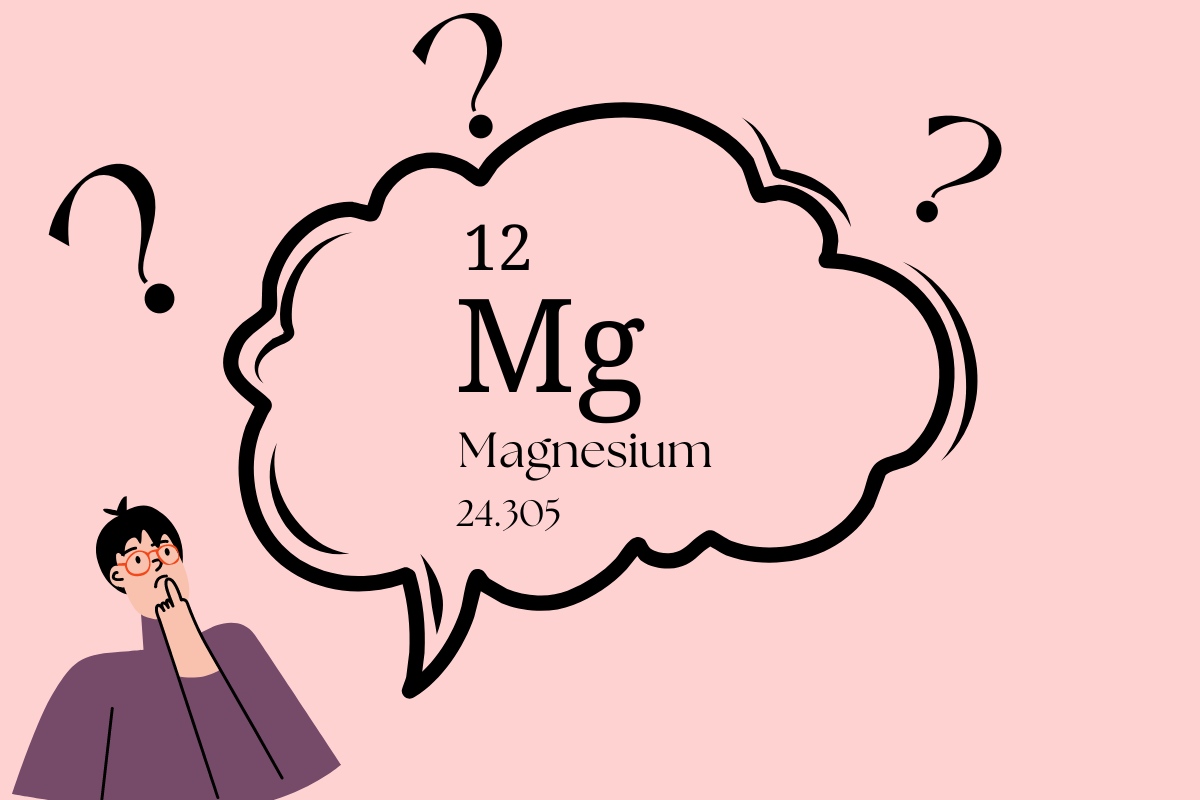Free shipping on orders over 45.00€
*Valid for orders up to 2kg
Free shipping on orders over 45.00€
*Valid for orders up to 2kg
Below you will find answers to the most common questions you ask us about magnesium! So read our article and....relax!
Magnesium is a mineral found in the human body. Adults have a total body content of about 25 g. The vast majority (99%) of total body magnesium is found intracellularly, primarily in bone, muscle and other soft tissues.

Magnesium regulates a variety of biochemical reactions and cellular functions because it acts as a cofactor in more than 600 enzymes.
Magnesium is a complex partner of ATP (adenosine triphosphate) and activates ATP-dependent enzymes such as kinases, nucleotidases, phosphatases and carboxypeptidases. This makes it essential for glycolysis, the citric acid cycle, lipid metabolism, amino acid activation, and nucleic acid synthesis, among others.
Magnesium forms complexes with nucleic acids and thus stabilizes DNA and RNA. As a complex with phospholipids, it stabilizes biological membranes. Magnesium also affects cellular ion channels and calcium, potassium and sodium transporters.
Due to its membrane and electrolyte regulating properties, magnesium is
Magnesium is involved in an incredible number of bodily processes. Below are some of its many functions:
Deficiency symptoms develop secondarily as a result of decreased intestinal magnesium absorption or increased renal magnesium excretion. Caused by gastrointestinal disorders such as acute or chronic diarrhea, vomiting, malabsorption, or small bowel resections/bypass. In addition, kidney disease, chronic alcohol consumption, and chronic use of certain medications (including diuretics, antibiotics, and contraceptives) may be the cause.
Symptoms of magnesium deficiency occur only at very low serum concentrations of less than 0,5 mmol/l. Magnesium, as we mentioned, is involved in many functions and interacts with other minerals, so specific symptoms are not solely due to magnesium deficiency.
The first signs may be
As the disease progresses, magnesium deficiency can lead to calcium and potassium deficiencies, as well as neurological and cardiovascular symptoms (eg, numbness, tingling, muscle cramps, sudden changes in behavior, and cardiac arrhythmias).

Almonds, sunflower and pumpkin seeds, as well as flaxseed and sesame are high in magnesium. Cereal products made from whole grains are also high in magnesium. Cocoa powder and dark chocolate also contain high amounts of magnesium.
Other sources of magnesium are legumes (eg beans, lentils, peas), green leafy vegetables (eg chard, spinach), fish (eg cod-like fish) and seafood (eg .eg shrimps).
Fruit juices (eg gooseberry juice) and water also provide magnesium. When it comes to drinking water, it depends on the source and the degree of hardness - the harder the water, the higher the concentration of magnesium.
The intake of high amounts of metals (calcium, phosphorus, iron, copper, manganese or zinc), e.g. through the intake of dietary supplements, it can inhibit the absorption of magnesium. In the case of normal dietary intake, magnesium absorption is not affected.
Magnesium as a dietary supplement is available in various forms in pharmacies as a dietary supplement. But which magnesium compound is right for your body and when do you need it?
So we explain what you should look out for the next time you buy magnesium in a food supplement.
You are using diglycinate magnesium (magnesium bisglycinate) because contributes to normal psychological function.
Magnesium malate offers a solution to fatigue because helps reduce fatigue and tiredness.
Magnesium citrate is ideal for people with an active lifestyle because contributes to normal muscle function.
Magnesium citrate, diglycinate or malate? The difference between the shapes.
Not all magnesium compounds are created equal. The form of magnesium determines how well magnesium is absorbed by the body.
The forms of magnesium can be divided into two groups:* The amount of elemental magnesium says something about the amount of "pure" mineral contained in the dietary supplement. And it shows how much of the active ingredient the body can actually use. For example, magnesium citrate contains 16 mg of magnesium and 84 mg of citric acid (citrate) per 100 mg of raw material.
Examples of organically and inorganically bound forms of magnesium:
Of all the forms of magnesium, the magnesium diglycinate is the most absorbable. Magnesium diglycine is a compound between magnesium and the amino acid glycine. Due to this compound, magnesium is well absorbed, especially in the brain. Therefore, the magnesium diglycinate contributes to normal psychological function.
Magnesium malate, citrate and taurate are compounds of magnesium with an organic acid. These organic acids also occur naturally in our bodies. And these magnesium compounds are easily absorbed.
Magnesium ascorbate is a form of vitamin C. Magnesium ascorbate provides mostly vitamin C, but also some magnesium.
Magnesium carbonate is the form of magnesium that occurs naturally in our bones.
Magnesium sulfate, chlorine, hydroxide and oxide are poorly absorbed by the body. Higher doses may also have a laxative effect and thus have a negative effect on the mineral balance in the body.
